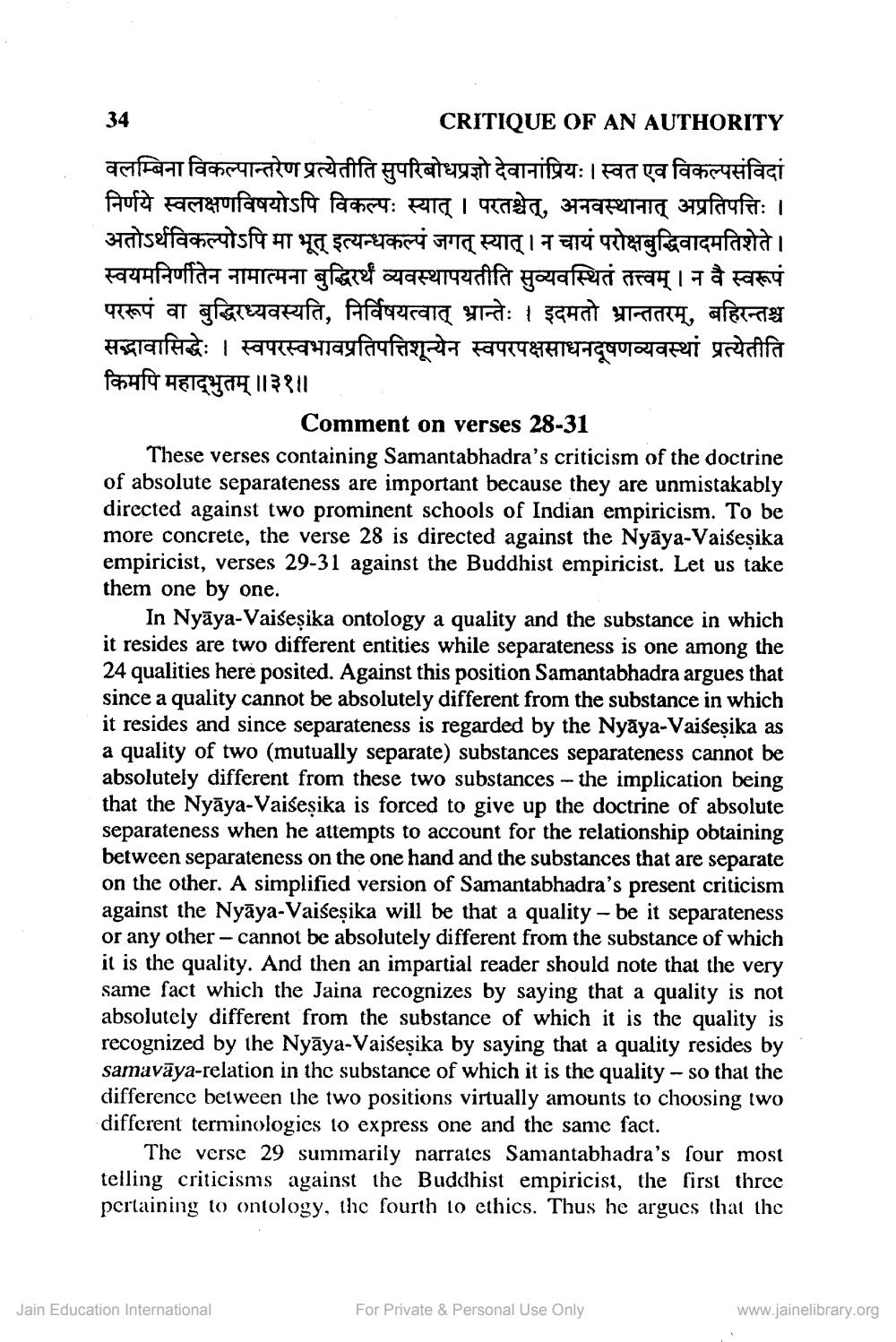________________
CRITIQUE OF AN AUTHORITY वलम्बिना विकल्पान्तरेण प्रत्येतीति सुपरिबोधप्रज्ञो देवानांप्रियः । स्वत एव विकल्पसंविदां निर्णये स्वलक्षणविषयोऽपि विकल्पः स्यात् । परतश्चेत्, अनवस्थानात् अप्रतिपत्तिः ।
अतोऽर्थविकल्पोऽपि मा भूत् इत्यन्धकल्पं जगत् स्यात् । न चायं परोक्षबुद्धिवादमतिशेते। स्वयमनिर्णीतेन नामात्मना बुद्धिरर्थं व्यवस्थापयतीति सुव्यवस्थितं तत्त्वम् । न वै स्वरूपं पररूपं वा बुद्धिरध्यवस्यति, निर्विषयत्वात् भ्रान्तेः । इदमतो भ्रान्ततरम्, बहिरन्तश्च सद्भावासिद्धेः । स्वपरस्वभावप्रतिपत्तिशून्येन स्वपरपक्षसाधनदूषणव्यवस्था प्रत्येतीति किमपि महाद्भुतम् ॥३१॥
Comment on verses 28-31 These verses containing Samantabhadra's criticism of the doctrine of absolute separateness are important because they are unmistakably directed against two prominent schools of Indian empiricism. To be more concrete, the verse 28 is directed against the Nyāya-Vaiśesika empiricist, verses 29-31 against the Buddhist empiricist. Let us take them one by one.
In Nyäya-Vaisesika ontology a quality and the substance in which it resides are two different entities while separateness is one among the 24 qualities here posited. Against this position Samantabhadra argues that since a quality cannot be absolutely different from the substance in which it resides and since separateness is regarded by the Nyāya-Vaiseșika as a quality of two (mutually separate) substances separateness cannot be absolutely different from these two substances - the implication being that the Nyāya-Vaiseșika is forced to give up the doctrine of absolute separateness when he attempts to account for the relationship obtaining between separateness on the one hand and the substances that are separate on the other. A simplified version of Samantabhadra's present criticism against the Nyāya-Vaisesika will be that a quality - be it separateness or any other - cannot be absolutely different from the substance of which it is the quality. And then an impartial reader should note that the very same fact which the Jaina recognizes by saying that a quality is not absolutely different from the substance of which it is the quality is recognized by the Nyāya-Vaiseșika by saying that a quality resides by samavāya-relation in the substance of which it is the quality -- so that the difference between the two positions virtually amounts to choosing two different terminologies to express one and the same fact.
The verse 29 summarily narrates Samantabhadra's four most telling criticisms against the Buddhist empiricist, the first three pertaining to ontology, the fourth to ethics. Thus he argues that the
Jain Education International
For Private & Personal Use Only
www.jainelibrary.org




